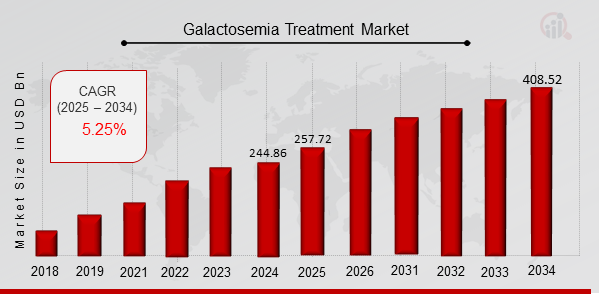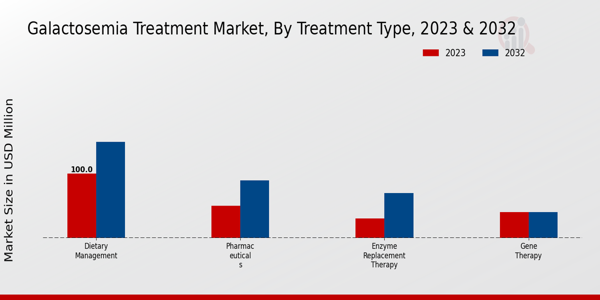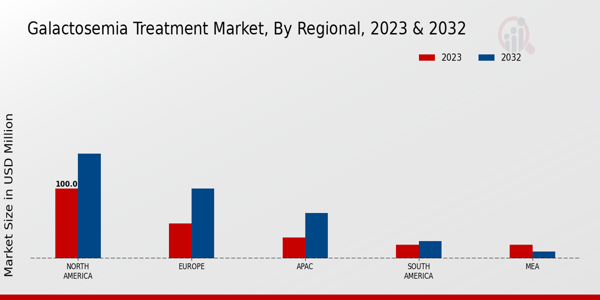Galactosemia Treatment Market Overview
As per MRFR analysis, the Galactosemia Treatment Market Size was estimated at 244.86 (USD Million) in 2024. The Galactosemia Treatment Market Industry is expected to grow from 257.72 (USD Million) in 2025 to 408.52 (USD Million) till 2034, at a CAGR (growth rate) is expected to be around 5.25% during the forecast period (2025 - 2034).
Key Galactosemia Treatment Market Trends Highlighted
The Galactosemia Treatment Market is primarily driven by the increasing prevalence of galactosemia and a growing awareness among healthcare providers and patients about this rare metabolic disorder. As more people are diagnosed, the demand for effective treatment options continues to rise. Advances in medical research are leading to the development of new therapies, which further fuels market growth. The introduction of newborn screening programs and educational initiatives are also enhancing early diagnosis and management of the condition, contributing to a larger patient population seeking treatment. There are significant opportunities to be explored in this market as new therapies and supportive care options continue to emerge.Manufacturers can invest in research and development to create more effective medications that address the specific needs of galactosemia patients. Collaboration with healthcare providers and patient advocacy groups can lead to better treatment awareness and adherence. The rise of telemedicine and digital health solutions presents an opportunity for improving patient engagement and follow-up care, especially in remote areas. Expanding access to treatment in developing regions can also create new market avenues. Recent trends in the Galactosemia Treatment Market indicate a shift towards personalized medicine. Tailoring treatment plans based on individual patient characteristics is becoming more prominent.Additionally, there is a noticeable increase in the adoption of dietary management strategies as part of a comprehensive treatment approach. The integration of technology, such as mobile health applications to track dietary intake and medication adherence, is also on the rise. Overall, the market is evolving to meet the unique needs of galactosemia patients through innovative approaches and collaborative efforts in treatment and support.

Source: Primary Research, Secondary Research, MRFR Database and Analyst Review
Galactosemia Treatment Market Drivers
Increasing Awareness and Diagnosis of Galactosemia
The growing awareness regarding rare genetic disorders, especially galactosemia, is one of the most significant drivers influencing the Galactosemia Treatment Market Industry's growth. With advancements in genetic testing and diagnostic strategies, more individuals are being diagnosed with galactosemia. Healthcare professionals are increasingly educated about the signs and symptoms of galactosemia, leading to early identification and treatment of affected individuals.As knowledge about this condition spreads among healthcare providers and patients alike, the demand for effective treatment options is expected to rise significantly. Awareness campaigns initiated by various health organizations play a crucial role in guiding families toward seeking proper medical advice and care. Furthermore, as public awareness rises, so too does the necessity for treatment solutions that can help manage the condition effectively.The increased visibility of galactosemia conditions aids in fostering innovation and research that may lead to better treatment protocols and pharmaceutical solutions, thereby contributing positively to the overall market dynamics. As the diagnosis rates improve and more patients emerge from previously undiagnosed populations, it will inevitably broaden the target demographic for treatment options in the Galactosemia Treatment Market, which will likely lead to significant growth and market expansion opportunities in the coming years.
Advancements in Medical Research and Treatment Options
The rapid advancement in medical research is fostering the development of new treatment options for galactosemia, significantly impacting the Galactosemia Treatment Market Industry. Researchers are continuously exploring innovative therapies, including enzyme replacement therapy and gene therapies, that promise to enhance patient outcomes. As pharmaceutical companies invest more in research and development, a range of potential therapies are expected to be introduced to the market, providing broader treatment solutions for affected individuals.This increased focus on developing effective treatments not only improves quality of life for patients but also serves to stimulate market growth as more options become available. Furthermore, collaboration between academic institutions, healthcare providers, and the pharmaceutical industry is creating a conducive environment for breakthroughs that can improve treatment regimens and open new avenues for managing the disease. The innovations in drug delivery systems and the emphasis on personalized medicine are anticipated to drive the transformation of treatment protocols significantly.
Growing Global Burden of Rare Diseases
The increasing prevalence of rare diseases, including galactosemia, is contributing to the growing demand for novel treatment methods and driving the Galactosemia Treatment Market Industry. With improved diagnostic techniques, more cases are being identified each year, highlighting the need for dedicated treatment and management strategies for the rising patient population. As healthcare systems adapt to these changes and recognize the need for specialized treatment options, there is a growing acceptance of the necessity for tailored healthcare solutions to address the challenges presented by rare diseases like galactosemia.This recognition not only influences healthcare policy but also stimulates research and development efforts aimed at providing effective therapies, further supporting industry growth.
Galactosemia Treatment Market Segment Insights:
Galactosemia Treatment Market Treatment Type Insights
The Galactosemia Treatment Market, segmented by Treatment Type, showcases impressive growth driven by increasing awareness and advancements in treatment methodologies. In 2023, the overall valuation of the market stood at 0.22 USD Million, with significant contributions from various treatment types. Dietary Management, recognized for its critical role in managing galactosemia, holds the majority with a valuation of 100.0 USD Million in 2023, anticipated to grow to 150.0 USD Million by 2032. This treatment type remains dominant mainly due to the foundational approach it provides for controlling galactose levels in patients. Pharmaceuticals also contribute substantially, valued at 50.0 USD Million in 2023 and expected to reach 90.0 USD Million by 2032. This segment is increasingly significant as pharmaceutical advancements lead to the development of drugs specifically targeting galactose metabolism, enhancing patient outcomes and compliance. Meanwhile, Enzyme Replacement Therapy shows noteworthy potential, starting at a valuation of 30.0 USD Million in 2023 and moving towards 70.0 USD Million in 2032. This treatment option presents a significant breakthrough as it provides a more direct approach to enzyme deficiency issues faced by patients.Lastly, Gene Therapy, while currently valued at 40.0 USD Million in 2023, is projected to remain at the same level in 2032. Although it lacks the growth expectations of the other treatments, its innovative nature represents a future opportunity within the industry as researchers continue exploring genetic interventions for the long-term management of galactosemia. The varied dynamics among these treatment types highlight unique growth drivers and challenges within the Galactosemia Treatment Market, rendering it a diverse domain ripe for further exploration and development. With an expected CAGR of 5.25 from 2024 to 2032, the market is positioned for substantial growth, shaped by ongoing research efforts and increased demand for effective treatment solutions. The significance of Dietary Management and Pharmaceuticals illustrates where the current focus lies, while Enzyme Replacement Therapy offers hope for future advancements, making each treatment type a valuable component of the overall market landscape.

Source: Primary Research, Secondary Research, MRFR Database and Analyst Review
Galactosemia Treatment Market Route of Administration Insights
The Galactosemia Treatment Market is positioned to show substantial growth within the Route of Administration segment. As of 2023, the overall market is valued at 0.22 million USD, and by 2032, it is expected to reach 350 million USD, reflecting a clear interest in treatments tailored for galactosemia. The segmentation within this market highlights various administration methods, with oral medications demonstrating a majority holding due to their ease of use and patient compliance. Intravenous administration is pivotal for acute management, allowing for rapid delivery of treatments in clinical settings when immediate intervention is necessary.Additionally, subcutaneous routes provide alternatives for patients who may require slower, controlled-release options, showcasing their significance in ongoing treatment plans. The evolving preferences for these routes are driven by the increased understanding of patient needs and the incorporation of innovative delivery mechanisms, thus offering various avenues for therapeutic applications in the Galactosemia Treatment Market. This growing landscape emphasizes the importance of customized approaches in medical practices as stakeholders seek to improve patient outcomes and optimize therapeutic efficiency across diverse routes of administration.
Galactosemia Treatment Market Patient Type Insights
The Galactosemia Treatment Market, focusing on the Patient Type segment, showcases a diverse landscape spanning various age groups, including infants, children, and adults. In 2023, the market was valued at 0.22 million USD, reflecting an increasing awareness and diagnosis of galactosemia, which has propelled demand for effective treatments. Infants represent a critical demographic as they are typically the first to be diagnosed and require immediate treatment to prevent long-term health complications. Consequently, this group significantly influences market dynamics.Children also play a vital role, as their treatment requires ongoing management to ensure appropriate dietary restrictions are maintained over time. Meanwhile, adults, though typically a smaller segment, present unique challenges. They often navigate the complexities of lifelong treatment and its impacts on lifestyle, highlighting the need for tailored therapies. The growth within the Galactosemia Treatment Market is driven by increased research, better screening programs, and advancements in dietary management that cater to the specific needs of these patient types.Discussing the Galactosemia Treatment Market segmentation, it is clear that each group presents unique opportunities and challenges that are essential in shaping the market's future trajectory. With the market expected to reach 350.0 million USD by 2032, these patient demographics will continue to play a pivotal role in driving market growth.
Galactosemia Treatment Market Distribution Channel Insights
The Distribution Channel segment of the Galactosemia Treatment Market plays a crucial role in ensuring that patients have access to essential treatment options. In 2023, the market was valued at 0.22 million USD, showcasing the foundational stage of the industry as it gears up for substantial growth. Among the diverse distribution channels, hospital pharmacies are increasingly important, as they provide specialized care and immediate access to medications for patients receiving treatment at healthcare facilities. Retail pharmacies offer a wide reach by catering to local communities, ensuring that patients can conveniently access their medications.Meanwhile, online pharmacies are making significant headway, driven by growing digital adoption and the preference for home delivery services, which improves patient compliance and convenience. With the market expected to grow significantly by 2032, these distribution channels will be pivotal in shaping the landscape of treatment accessibility and patient care, driving demand for Galactosemia treatments across various geographical locations and demographics. Overall, the Galactosemia Treatment Market segmentation highlights the importance of each channel in meeting patient needs and advancing treatment for galactosemia.
Galactosemia Treatment Market Regional Insights
The Galactosemia Treatment Market is witnessing significant growth across various regions, with a projected value of 0.22 USD Million in 2023, growing to 350.0 USD Million by 2032. North America holds the majority share, valued at 100.0 USD Million in 2023, reflecting the region's established healthcare infrastructure and growing awareness regarding galactosemia. Europe follows with a valuation of 50.0 USD Million in 2023, showcasing substantial interest in innovative treatment solutions. The APAC region, valued at 30.0 USD Million, is emerging as an important market, driven by increased healthcare expenditure and rising incidences of metabolic disorders.South America, with a valuation of 20.0 USD Million, presents a nascent market, while the MEA region holds 20.0 USD Million. However, the MEA market is expected to experience a decline by 2032, indicating potential challenges such as healthcare access and treatment affordability. Overall, the Galactosemia Treatment Market segmentation highlights diverse growth dynamics and opportunities that stakeholders must strategically navigate for long-term success.

Source: Primary Research, Secondary Research, MRFR Database and Analyst Review
Galactosemia Treatment Market Key Players and Competitive Insights:
The Galactosemia Treatment Market is characterized by a dynamic landscape of competition, driven by increasing awareness of the disorder and advancements in treatment options. Galactosemia is a rare genetic disorder that affects the body's ability to process galactose, leading to serious health complications if untreated. As the market progresses, pharmaceutical companies and research organizations are focusing on developing innovative therapies and improving existing treatment protocols. The competition is intensified by collaborations across the biotech and pharmaceutical industries, which aim to streamline drug discovery and enhance therapeutic efficacy. Furthermore, the introduction of comprehensive screening programs and improvements in patient management significantly contribute to the market's growth, creating opportunities for new entrants and established players alike.Sumitomo Dainippon Pharma has developed a significant presence within the Galactosemia Treatment Market through its commitment to research and development in rare diseases. The company has focused on enhancing its portfolio by investing in innovative therapies and fostering partnerships with leading research institutions. The strengths of Sumitomo Dainippon Pharma lie in its extensive expertise in the field of rare genetic disorders, alongside a dedicated team committed to advancing treatment modalities that cater to patients with galactosemia. Their robust clinical trial capabilities and strategic initiatives that prioritize patient safety and efficacy highlight their competitive edge. The company's ability to adapt to market needs and its focus on patient-oriented solutions fortify its position within this niche market.Clinical Research Services has positioned itself as a valuable player in the Galactosemia Treatment Market by offering critical support for clinical development projects. Specializing in conducting clinical trials, the company is well-equipped to facilitate the testing of new therapies aimed at treating galactosemia. Its strengths include a comprehensive understanding of regulatory processes and a network of experienced clinicians and researchers, which enables efficient study execution while adhering to strict compliance guidelines. Clinical Research Services emphasizes a patient-centric approach, ensuring that trials are designed to address the specific needs of those affected by galactosemia. By providing essential clinical insights and fostering collaboration with pharmaceutical companies and stakeholders, this organization plays a vital role in advancing treatment options and enhancing therapeutic efficacy for patients suffering from this rare metabolic disorder.
Key Companies in the Galactosemia Treatment Market Include:
- Sumitomo Dainippon Pharma
- Clinical Research Services
- Sobi
- Eisai
- Vertex Pharmaceuticals
- Genzyme
- Amicus Therapeutics
- Horizon Therapeutics
- Qilu Pharmaceutical
- Alnylam Pharmaceuticals
- BioMarin Pharmaceutical
- Takeda Pharmaceutical
- Incyte Corporation
- Shire
Galactosemia Treatment Market Industry Developments
The Galactosemia Treatment Market has recently witnessed significant developments, particularly focusing on advancements in therapeutic options. Companies such as BioMarin Pharmaceutical and Alnylam Pharmaceuticals are leading the charge with clinical trials aimed at improving treatment efficacy and patient outcomes. There is increasing interest in enzyme replacement therapies, which are being explored by firms like Genzyme and Sobi to address the underlying metabolic deficiencies in galactosemics. Additionally, the market has seen strategic partnerships and alliances, with organizations such as Horizon Therapeutics and Amicus Therapeutics collaborating to enhance research capabilities and accelerate product development. Moreover, Sumitomo Dainippon Pharma and Vertex Pharmaceuticals have announced expansions in their research departments to focus more intensively on rare metabolic disorders. While no recent mergers or acquisitions were highlighted among the companies, the ongoing innovations and collaborations are positively impacting market growth and generating increased valuation for involved companies, indicating a proactive response to emerging market needs. The heightened focus on personalized medicine also signifies a shift in treatment paradigms, enhancing therapeutic offerings in the galactosemia space.
Galactosemia Treatment Market Segmentation Insights
- Galactosemia Treatment Market Treatment Type Outlook
- Dietary Management
- Pharmaceuticals
- Enzyme Replacement Therapy
- Gene Therapy
- Galactosemia Treatment Market Route of Administration Outlook
- Oral
- Intravenous
- Subcutaneous
- Galactosemia Treatment Market Patient Type Outlook
- Galactosemia Treatment Market Distribution Channel Outlook
- Hospital Pharmacies
- Retail Pharmacies
- Online Pharmacies
| Report Attribute/Metric |
Details |
|
Market Size 2024
|
244.86 (USD Million)
|
|
Market Size 2025
|
257.72 (USD Million)
|
|
Market Size 2034
|
408.52 (USD Million)
|
|
Compound Annual Growth Rate (CAGR)
|
5.25 % (2025 - 2034)
|
|
Report Coverage
|
Revenue Forecast, Competitive Landscape, Growth Factors, and Trends
|
|
Base Year
|
2024
|
|
Market Forecast Period
|
2025 - 2034
|
|
Historical Data
|
2020 - 2024
|
| Market Forecast Units |
USD Million |
| Key Companies Profiled |
Sumitomo Dainippon Pharma, Clinical Research Services, Sobi, Eisai, Vertex Pharmaceuticals, Genzyme, Amicus Therapeutics, Horizon Therapeutics, Qilu Pharmaceutical, Alnylam Pharmaceuticals, BioMarin Pharmaceutical, Takeda Pharmaceutical, Incyte Corporation, Shire |
| Segments Covered |
Treatment Type, Route of Administration, Patient Type, Distribution Channel, Regional |
| Key Market Opportunities |
Innovative enzyme replacement therapies, Enhanced newborn screening programs, Increasing awareness and education initiatives, Genetic counseling advancements, Rising prevalence of galactosemia |
| Key Market Dynamics |
increasing prevalence of galactosemia, advancements in gene therapy, dietary management challenges, rising awareness and diagnosis, development of novel therapeutics |
| Countries Covered |
North America, Europe, APAC, South America, MEA |
Frequently Asked Questions (FAQ) :
The Galactosemia Treatment Market is expected to be valued at 408.52 million USD by 2034.
The market is projected to grow at a CAGR of 5.25% from 2025 to 2034.
North America is expected to dominate the market with a valuation of 150.0 million USD by 2032.
The market value for Dietary Management is expected to reach 150.0 million USD by 2032.
The Pharmaceuticals segment is expected to hold a market value of 90.0 million USD by 2032.
Enzyme Replacement Therapy is expected to reach 70.0 million USD in market size by 2032.
The Gene Therapy segment is anticipated to maintain a market size of 40.0 million USD by 2032.
Key players include Sumitomo Dainippon Pharma, Vertex Pharmaceuticals, and BioMarin Pharmaceutical, among others.
The APAC region is expected to have a market value of 65.0 million USD by 2032.
Challenges include regulatory hurdles and the high cost of treatment options.

















